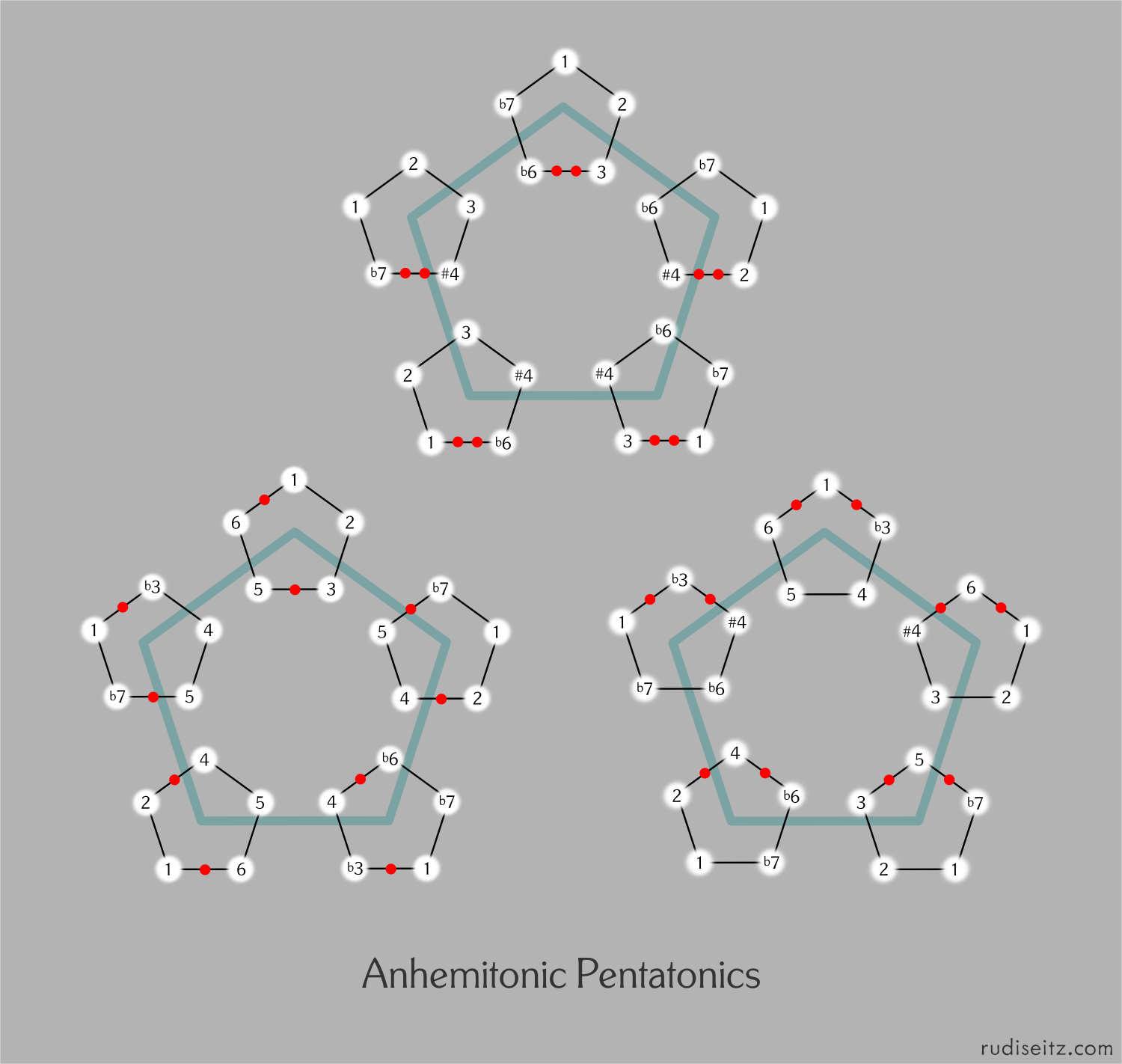Here’s a look at the complete set of possibilities for anhemitonic pentatonic scales–that is, five-note scales that don’t contain semitones. Some of the most widely used scales in various musical traditions belong to this collection, including the major pentatonic (1, 2, 3, 5, 6) and the minor pentatonic (1, b3, 4, 5, b7). While you can build a dizzying array of pentatonic scales with semitones, it turns out there are only a few you can build without them–the possibilities boil down to fifteen scales belonging to only three modal families. It’s not hard to see why the options are so limited. If we’re building a pentatonic scale, we have to include five notes from the twelve available notes in the octave–let’s represent these “included” notes as white dots on the vertices of a pentagon:
If our scale has no semitones, then there must be an excluded note between any two included ones. We’ll represent these as red dots on the pentagon’s edges:
Without making any choices to “customize” our scale, we’ve already accounted for ten notes: there must be five excluded notes somewhere between the five included notes. We only have two notes in the octave left to play with, and all we can do is decide which edge or edges of the pentagon to put them on. Since we know that each edge has at least one excluded note, we might as well remove the corresponding red dots from our diagram and start with blank edges. (All we’ll be doing from now on is adding more red dots, and the order in which we place multiple red dots on the same edge isn’t significant, so the first five red dots have no bearing on our upcoming choices.)
So how many different ways are there of positioning our two remaining dots on blank edges of a pentagon? We’re looking for arrangements that are distinct in the sense that they can’t be rotated to match each other (in musical terms, this is the same as requiring that two scales can’t be transposed so their notes coincide). There are only three distinct arrangements:
For each of these arrangements, we can create five modes, depending on which white dot we choose as the root. An edge with one red dot means there will be two excluded notes between the white endpoints (remember that we dropped one of those excluded notes to simplify the diagram), which means the endpoints will be separated by three semitones or a minor third (m3). Similarly, an edge with two red dots represents a major third (M3). An edge with no red dots represents a whole tone (M2). Walking around the pentagon clockwise, you can extract the interval pattern for the scale as a sequence of whole tones, minor thirds, and major thirds.
Our first template (two red dots together on one edge) represents the interval pattern M2-M2-M3-M2-M2 and generates all of the five-note subsets of the whole-tone scale. This is fascinating material, but not what comes to everyone’s mind they hear the word “pentatonic.” Our second template (red dots on adjacent edges) represents the interval pattern m3-M2-M2-M2-m3 and also creates some uncommon pentatonics, although one of these (1, b3, 4, 5, 6) can be seen as a subset of the Dorian mode of the major scale, or as a subset of the melodic minor scale. The third template (red dots separated by one edge on one side, and two on another) represents the interval pattern M2-M2-m3-M2-m3 and generates the familiar major and minor pentatonics.
The diagram below includes all fifteen possibilities. The five modes of each of the three template are arranged around the points of three large pentagons. As you move clockwise around one of the large pentagons, you’ll see that the root note in the small pentagon (the white dot labeled 1) shifts around, while the red dots remains in place. The remaining vertices in each small pentagon are labeled as scale degrees relative to the given root.
[Note: I’ve proofread this diagram once, but please let me know if you spot any errors in the scale-degree labeling.] ■



